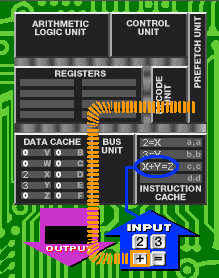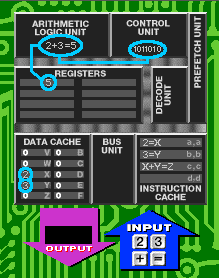When you press the "+" key the Prefetch Unit asks the computer's main memory and Instruction Cache for instructions on the new data, which must be fetched from main memory. Because this is a new instruction, the "+" comes into the microprocessor from the computer's main memory and gets stored at an address in the Instruction Cache as a code "X+Y=Z," showing that the act of adding is going to take place. |
 |
|
The Prefetch Unit then asks the Instruction Cache for a copy of the code "X+Y=Z" and sends it to the Decode Unit for further processing. In the Decode Unit, "X+Y=Z" is translated or decoded and sent off to the Control Unit and the Data Cache to tell them what to do with the instruction—also the ALU is given a message that an ADD function will be performed. |
 |
|
In the Control Unit, the code is broken down and the ADD command is sent to the ALU where "X" and "Y" are added together after they have been sent up from the Data Cache. The ALU then talks to its buddy, the Registers, and sends the "5" over to be stored in one of the address locations there. |
 |